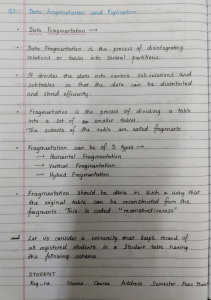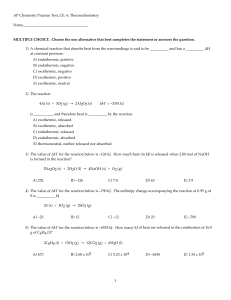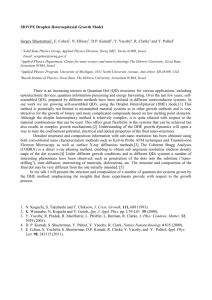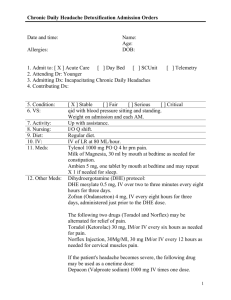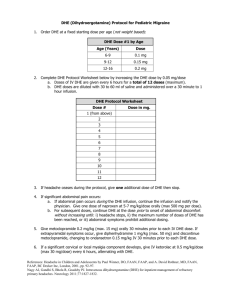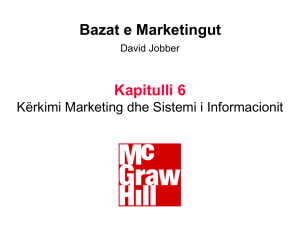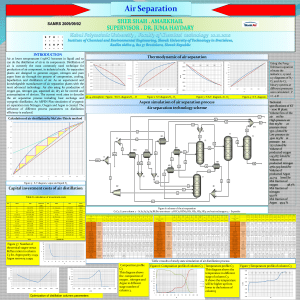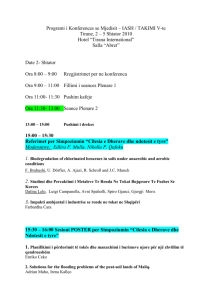File
advertisement
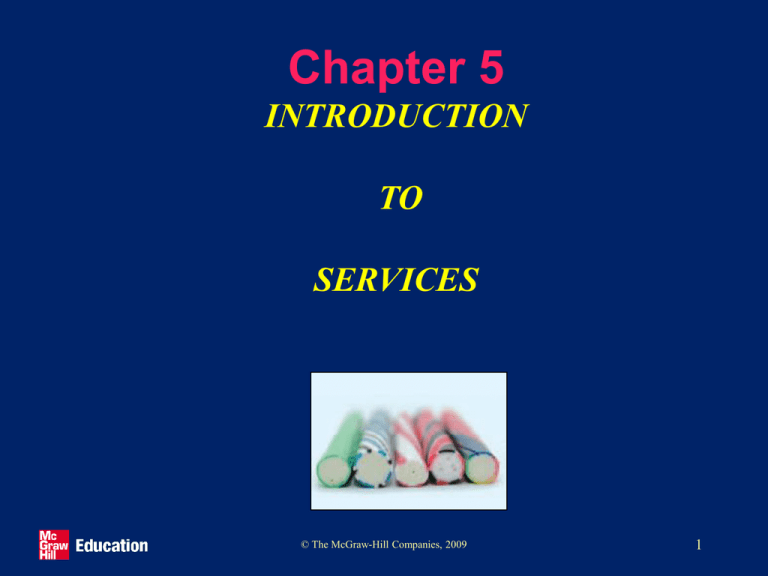
Chapter 5 INTRODUCTION TO SERVICES © The McGraw-Hill Companies, 2009 1 A note on the PowerPoint Slides... These PowerPoint slides contain selected exhibits, figures and tables from the chapters as well as objectives for the chapters. For many chapters, we include extra lecture slides and in-class exercises that we have compiled and used in our classes. The lecture slides are not intended to provide full outlines or complete lectures for the chapters, but rather may be used selectively to enhance class sessions. Objectives for Chapter : Introduction to Services • Te shpjegojmë se çfarë shërbime janë dhe identifikimin e trendeve të shërbimit • Te shpjegojmë nevojën për koncepte të shërbimeve speciale të marketingut dhe të praktikave • Përshkruajmë dallimet bazë në mes të mallrave dhe shërbimeve si dhe sfidat që rezultojnë për shërbim • Prezantoni trekëndëshin e marketingut të shërbimeve • Prezantoni zgjeruar shërbimet e marketingut mix • Zbatimi i modelit boshllëqet e cilësisë së shërbimit Sfidat për Shërbimet Përcaktimin dhe përmirësimin e cilësisë Komunikimi dhe testimin e shërbimeve të reja Komunikimi dhe mbajtjen e një imazhi të qëndrueshme Motivimi dhe mbajtjen e angazhimit të punonjësve Koordinimin, marketing, operacionet dhe përpjekjet e burimeve njerëzore Vendosja e çmimeve të Standardizimit kundrejt personalizimit © The McGraw-Hill Companies, 2009 Shembuj te Sherbimeve Health Care Professional Services restaurant, hotel/motel, bed & breakfast, ski resort, rafting Travel banking, investment advising, insurance Hospitality accounting, legal, architectural Financial Services hospital, medical practice, dentistry, eye care airlines, travel agencies, theme park Others: hair styling, pest control, plumbing, lawn maintenance, counseling services, health club © The McGraw-Hill Companies, 2009 Figure 1-1 Spektri I (pa)prekshmerise Salt Soft Drinks Detergents Automobiles Cosmetics Fast-food Outlets Tangible (prekshem) Dominant Fast-food Outlets Intangible (paprekshem) Dominant Advertising Agencies Airlines Investment Management Consulting Teaching Figure 1-2 Percent of U.S. Labor Force by Industry Percent of GDP 80 70 60 50 40 30 20 10 0 1929 1948 1969 1977 1984 1996 Year Source: Survey of Current Business, April 1998, Table B.8, July 1988, Table 6.6B, and July 1992, Table 6.4C; Eli Ginzberg and George J. Vojta, “The Service Sector of the U.S. Economy,” Scientific American, 244,3 (1981): 31-39. Services Manufacturing Mining & Agriculture Figure 1-3 Percent of U.S. Gross Domestic Product by Industry Percent of GDP 80 70 60 50 40 30 20 10 0 1948 1959 1967 1977 1987 1996 Year Source: Survey of Current Business, August 1996, Table 11, April 1998, Table B.3; Eli Ginzberg and George J. Vojta, “The Service Sector of the U.S. Economy,” Scientific American, 244,3 (1981): 31-39. Services Manufacturing Mining & Agriculture Dallimi ne mes Produkteve dhe sherbimeve- IHIP Intangibility Heterogeneity Papreshmeria Llojllojshmeria Simultaneous Production And Consumption Prodhimi dhe Konsum Simultan Inseperebality PANDARSHMERIA Perishability Venitja Implications of IntangibilityPaprekshemria Shërbimet nuk mund të(inventarizohen)ruhen Shërbime nuk mund të patentohen Shërbimet nuk mund të shfaqen lehtësisht ose komunikohen Vendosja e Çmimit është e vështirë Implications of Heterogeneity Llojllojshmeria Ofrimi i shërbimit dhe kënaqësia e konsumatorëve varet nga veprimet e punonjësit Cilësia e shërbimit varet nga shumë faktorë të pakontrollueshme Nuk ka njohuri të sigurtë që shërbimit e dhëna përputhet me atë çfarë ishte planifikuar dhe nxitur Implications of Simultaneous Production and ConsumptionPandarshmeria Mass production is difficult Konsumatorët marrin pjesë në dhe ndikojë në transaksion Konsumatorët ndikojnë njëri-tjetrin Punonjësve ndikojnë në rezultatin e shërbimit Decentralizimi mund të jetë thelbësore Prodhimi masiv është i vështirë Implications of Perishability- Venitja Është vështirë për të sinkronizuar kërkesën dhe ofertën - per shërbimet Shërbime nuk mund të kthehet ose rishiten Table 1-2 Services are Different Goods Services Resulting Implications Tangible Intangible Services cannot be inventoried. Services cannot be patented. Services cannot be readily displayed or communicated. Pricing is difficult. Standardized Heterogeneous Service delivery and customer satisfaction depend on employee actions. Service quality depends on many uncontrollable factors. There is no sure knowledge that the service delivered matches what was planned and promoted. Production separate from consumption Simultaneous production and consumption Nonperishable Perishable Customers participate in and affect the transaction. Customers affect each other. Employees affect the service outcome. Decentralization may be essential. Mass production is difficult. It is difficult to synchronize supply and demand with services. Services cannot be returned or resold. Source: Adapted from Valarie A. Zeithaml, A. Parasuraman, and Leonard L. Berry, “Problems and Strategies in Services Marketing,” Journal of Marketing 49 (Spring 1985): 33-46. Figure 1-5 The Services Marketing Triangle Company (Management) Internal Marketing External Marketing “enabling the promise” Employees “setting the promise” Interactive Marketing Customers “delivering the promise” Source: Adapted from Mary Jo Bitner, Christian Gronroos, and Philip Kotler Kompania (Menaxhmenti Marketingu i brendshëm “Mundësimi i premtimit” Punonjësit Marketingu bashkëveprues “Plotësimi i premtimit” Marketingu i jashtëm “Bërja e premtimit” Konsumatorët 16 Services Marketing Triangle Applications Exercise Focus on a service organization. In the context you are focusing on, who occupies each of the three points of the triangle? How is each type of marketing being carried out currently? Are the three sides of the triangle well aligned? Are there specific challenges or barriers in any of the three areas? Ways to Use the Services Marketing Triangle Overall Strategic Assessment Specific Service Implementation How is the service organization doing on all three sides of the triangle? • What is being promoted and by whom? • How will it be delivered and by whom? • Where are the weaknesses? • • What are the strengths? Are the supporting systems in place to deliver the promised service? • Figure 1-6 The Services Triangle and Technology Company Technology Providers Source: Adapted from A. Parasuraman Customers Services Marketing Mix: 7 Ps for Services Traditional Marketing Mix Expanded Mix for Services: 7 Ps Building Customer Relationships Through People, Processes, and Physical Evidence Ways to Use the 7 Ps © The McGraw-Hill Companies, 2009 Traditional Marketing Mix All elements within the control of the firm that communicate the firm’s capabilities and image to customers or that influence customer satisfaction with the firm’s product and services: Product Price Place Promotion © The McGraw-Hill Companies, 2009 Expanded Mix for Services -the 7 Ps Product Price Place Promotion People Process Physical Evidence © The McGraw-Hill Companies, 2009 Table 1-3 Expanded Marketing Mix for Services PRODUCT PLACE PROMOTION PRICE Physical good Channel type features Promotion blend Flexibility Quality level Exposure Salespeople Price level Accessories Intermediaries Advertising Terms Packaging Warranties Outlet location Sales promotion Transportation Publicity Product lines Storage Branding Differentiation Allowances Table 1-3 (Continued) Expanded Marketing Mix for Services PEOPLE PHYSICAL EVIDENCE PROCESS Employees Facility design Flow of activities Customers Equipment Number of steps Communicating culture and values Signage Level of customer involvement Employee research Employee dress Other tangibles 7 P-jat People / Njerzit • Përzgjedhja e puntorëve • Trajnimi I Puntorëve • Motivimi I Puntorëve Promovimi (Promotion) 4 Njerëzit (People) Objektet fizike (Physical evidence) Vendi (Place) Menaxhimi i proceseve (Processes) Produkti (Product) Çmimi (Price) Physical evidence/ Evidenca Fizike Gjithqkca cka e perjetoni me Shqisa ( sy, prekne, ere , etj) •Dukja e Jashtme •Dekorimi/ detajet •Qasje e leht/ Process management •Si janë konsumatorët të trajtuar dhe menagjuar që nga pika e kontaktit të parë deri te pika e fundit e kontaktit 3 Ways to Use the 7 Ps Overall Strategic Assessment How effective is a firm’s services marketing mix? Is the mix well-aligned with overall vision and strategy? What are the strengths and weaknesses in terms of the 7 Ps? Specific Service Implementation Who is the customer? What is the service? How effectively does the services marketing mix for a service communicate its benefits and quality? What changes/improvements are needed?
